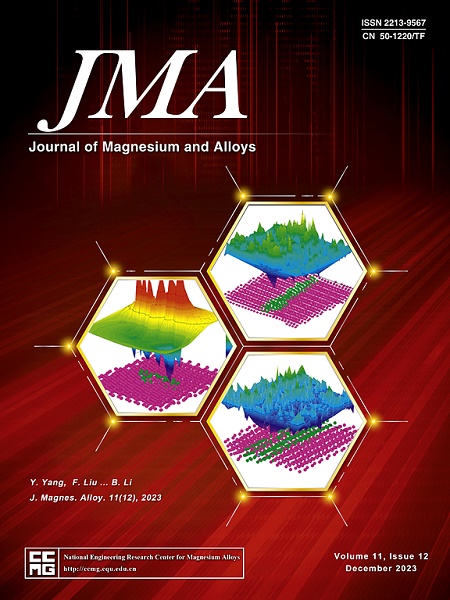Mg-RE二元合金时效过程早期析出行为的动力学模拟
IF 15.8
1区 材料科学
Q1 METALLURGY & METALLURGICAL ENGINEERING
引用次数: 0
摘要
镁稀土合金的析出行为对其性能起着至关重要的作用。然而,降水发生在小长度和长时间尺度上,使其难以用最先进的实验技术进行分析。本文结合分子动力学力场在描述原子相互作用方面的优势和蒙特卡罗方法在描述扩散事件方面的优势,建立了基于嵌入原子法(EAM)势的动力学蒙特卡罗(KMC)模型。利用该模型模拟了空位机制形成的Mg-Y合金中Y团簇的形成和演化,并利用像差校正扫描透射电镜表征对模拟结果进行了合理化。通过对Y原子的示踪,并与密度泛函理论(DFT)的计算结果进行比较,对Y簇的原子结构、演化动力学和路径进行了系统的分析。我们的研究表明,同一簇中的所有溶质柱都有沿[0001]Mg方向同步生长的趋势。本文提出的方法不仅适用于Mg-Y合金,也适用于Mg-Gd等其他Mg-RE合金。本文章由计算机程序翻译,如有差异,请以英文原文为准。
Kinetic simulation of early-stage precipitation behavior in Mg-RE binary alloys during aging process
The precipitation behavior of magnesium-rare earth (Mg-RE) alloys plays a crucial role for their properties. However, the precipitation happens at small-length and long-time scales, making it challenging to be analyzed by state-of-the-art experimental techniques. Here, we combine the advantages of both molecular dynamic force fields on describing atom interactions and Monte Carlo method on describing diffusive events to develop an embedded atom method (EAM) potential based kinetic Monte Carlo (KMC) model. Using the proposed model, we simulated the formation and evolution of Y clusters in Mg-Y alloy formed by the vacancy mechanism, and rationalize the simulation results using aberration-corrected scanning transmission electron microscopy characterize. We conducted a systematic analysis of the atomic structure, the evolution kinetics and path of the Y cluster by tracing Y atoms and comparing with density function theory (DFT) calculations. Our work reveals that, all solute columns in a same cluster trend to grow along the [0001]Mg direction synchronously. The method presented is not only used for the Mg-Y alloy but also other Mg-RE alloys such as Mg-Gd as illustrated in the last part of the paper.
求助全文
通过发布文献求助,成功后即可免费获取论文全文。
去求助
来源期刊

Journal of Magnesium and Alloys
Engineering-Mechanics of Materials
CiteScore
20.20
自引率
14.80%
发文量
52
审稿时长
59 days
期刊介绍:
The Journal of Magnesium and Alloys serves as a global platform for both theoretical and experimental studies in magnesium science and engineering. It welcomes submissions investigating various scientific and engineering factors impacting the metallurgy, processing, microstructure, properties, and applications of magnesium and alloys. The journal covers all aspects of magnesium and alloy research, including raw materials, alloy casting, extrusion and deformation, corrosion and surface treatment, joining and machining, simulation and modeling, microstructure evolution and mechanical properties, new alloy development, magnesium-based composites, bio-materials and energy materials, applications, and recycling.
 求助内容:
求助内容: 应助结果提醒方式:
应助结果提醒方式:


